

Help! Linux ate my RAM! ATTENTION INFO. RapidDisk, A New Linux RAM Disk Kernel Module - Phoronix Forums. RapidDisk, A New Linux RAM Disk Kernel Module. Released last month was RapidDisk 1.0, which is a Linux kernel module that up to this point has received little attention on the Internet.

RapidDisk is a new Linux RAM disk kernel module like the brd and zram modules, but with a different feature-set. Petros Koutoupis is the developer of RapidDisk (also known as rxdsk) is designed for high-performance computing while being designed to be simple. RapidDisk can handle dynamically adding or removing RAM-based block devices of varying sizes, LZO data compression (still being implemented), and SHA-256-based error-correction.
RapidDisk is meant to be used for quick I/O storage (such as using a solid-state drive for the RapidDisk), application/database caching, file-system meta-data caching, virtualization, and as possible replacements to CompCache and CacheFS. RapidDisk volumes can also be easily exported as a physical device across a SAN or allocated as a SWAP space. An open source advanced Linux RAM drive module collection. Move Chrome's Cache To RAM (Guide For Linux Users) - InsanityBit. Browsers will keep ‘pieces’ of a webpage in what’s called a cache.

This cache allows them to quickly pull files from the disk (which is quite somewhat quick) instead of having to redownload them (which is slow). Your system’s RAM is even faster than your disk, hundreds of times so, and keeping a file in RAM means accessing it will be nearly instant. Browsers are going to load up these files to RAM regardless but we can speed up writes to the cache and improve privacy by having the entire cache kept in RAM from the beginning. Ubuntu – Move Google Chrome cache from SSD to RAM. Running an SSD for the main boot partition is quite convenient for any OS, including Ubuntu.
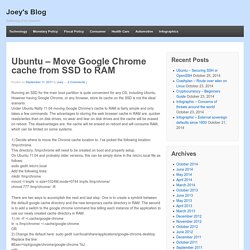
However having Google Chrome, or any browser, store its cache on the SSD is not the ideal scenario. Under Ubuntu Natty 11.04 moving Google Chrome’s cache to RAM is fairly simple and only takes a few commands. The advantages to storing the web browser cache in RAM are: quicker reads/writes than on disk drives, no wear and tear on disk drives and the cache will be erased on reboot. The disadvantages are: the cache will be erased on reboot and will consume RAM, which can be limited on some systems. 1) Decide where to move the Chrome cache location to.
Cods Plaice: Speeding up your Linux browser using a ramdisk. I came across an interesting article yesterday, about someone who had speeded up their browser on Windows by using a ramdisk, and knowing that Linux can happily do this, I decided to write down how to do this for the Linux user.
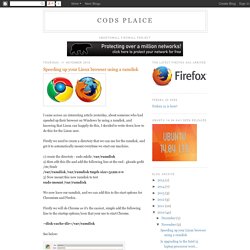
Firstly we need to create a directory that we can use for the ramdisk, and get it to automatically mount everytime we start our machine. 1) create the directoty - sudo mkdir /var/ramdisk 2) then edit this file and add the following line at the end - gksudo gedit /etc/fstab. Move Firefox and Chrome's Cache to a RAM Disk for Faster Browsing. Linux Ramdisk mini-HOWTO. Introduction What is a RAM disk?
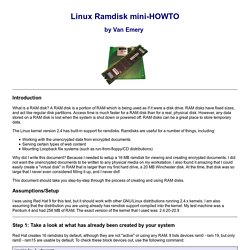
A RAM disk is a portion of RAM which is being used as if it were a disk drive. RAM disks have fixed sizes, and act like regular disk partitions. Access time is much faster for a RAM disk than for a real, physical disk. However, any data stored on a RAM disk is lost when the system is shut down or powered off. Create a RAM disk in Linux. There are many reasons for creating a memory based file system in Linux, not least of which is to provide a near zero latency and extremely fast area to story files.
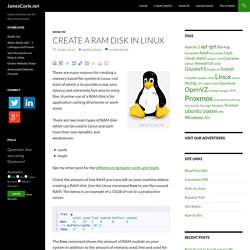
A prime use of a RAM disk is for application caching directories or work areas. There are two main types of RAM disk which can be used in Linux and each have their own benefits and weaknesses: Linux RAM Disk: Creating A Filesystem In RAM. By Vivek Gite on March 5, 2010 Software RAM disks use the normal RAM in main memory as if it were a partition on a hard drive rather than actually accessing the data bus normally used for secondary storage such as hard disk.
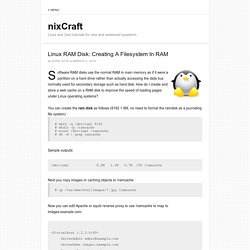
How do I create and store a web cache on a RAM disk to improve the speed of loading pages under Linux operating systems? You can create the ram disk as follows (8192 = 8M, no need to format the ramdisk as a journaling file system) : # mkfs -q /dev/ram1 8192 # mkdir -p /ramcache # mount /dev/ram1 /ramcache # df -H | grep ramcache Sample outputs:
Applications : How to use a Ramdisk for Linux. How to use a Ramdisk for Linux Abstract: This article shows how to use RAM as a virtual harddisk.
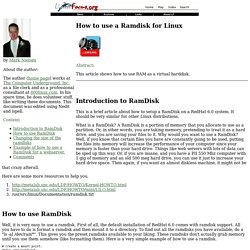
Tutorial: Creating a basic Linux RAM disk with VisualKernel. This tutorial shows how to create a basic RAM disk kernel module for Linux 3.x using VisualKernel.
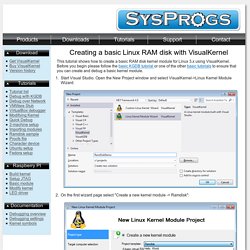
Before you begin please follow the basic KGDB tutorial or one of the other basic tutorials to ensure that you can create and debug a basic kernel module. Start Visual Studio. Open the New Project window and select VisualKernel->Linux Kernel Module Wizard: On the first wizard page select "Create a new kernel module -> Ramdisk": On the next wizard page select the computer you are targeting: On the third page you can change the directory where the sources will be stored on just press "Next" to accept the default directory: On the last page select a debugging method that corresponds to your setup (e.g. KGDB or VMWare): Press "Finish" to have your project generated. Linux initial RAM disk (initrd) overview. Learn about its anatomy, creation, and use in the Linux boot process M.

JonesPublished on July 31, 2006 What's an initial RAM disk? How do I use a RAM disk to help speed up disk-intensive applications? Jack Wallen explains how to create a RAM disk on your Windows PC and how it can be used to increase the performance of disk-intensive applications. There are certain applications that do an unusual amount of reading and writing data. Under normal operating circumstances, these applications work fine. » Linuxaria – Everything about GNU/Linux and Open source Ram Disk su Linux. Creating a ram disk on Linux.
Attenzione. How to find size of RAM cache use for ramfs, tmpfs. Attenzione. Dirty_ratio. Hyperlink. Programmi Utili, Good Softwares. RAMdisk.